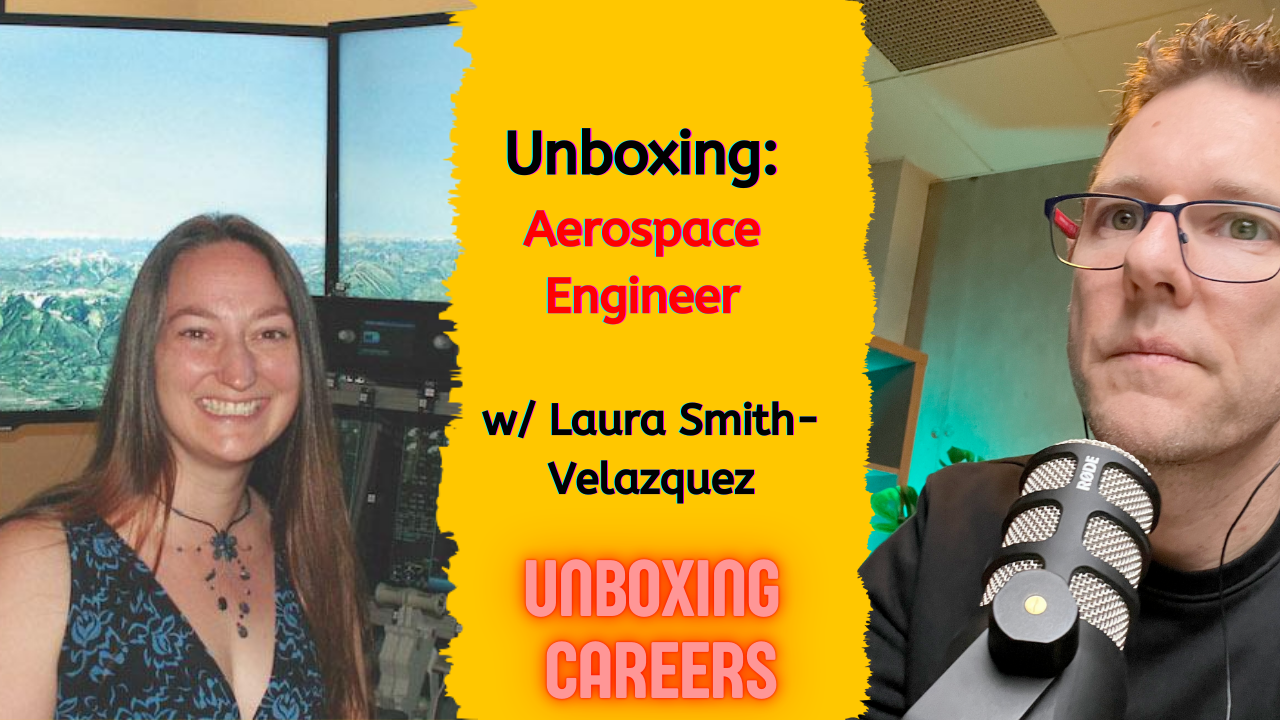29 Aerospace Engineer
What is it Like Being an Aerospace Engineer
On this episode of the Unboxing Careers Podcast, Greg Zakowicz unboxes the career of an Aerospace Engineer with Laura Smith-Velazquez.
Guest: Laura Smith-Velazquez is an aerospace engineer, though she is also called a human factors and systems engineer, cognitive systems engineer, experimental psychologist, and engineering psychologist. She applies the limitations and characteristics of people to the design of products in the aerospace industry to make them safer, more reliable, efficient, easier, and more fun to use.
Connect with Laura:
Listen: Spotify | Apple Podcasts | Amazon Music
We delve into the fascinating world of aerospace engineering with Laura Smith-Velazquez, who is not only an aerospace engineer but also a human factors and systems engineer and cognitive scientist. Laura Smith-Velazquez describes her work designing interfaces for aircraft and spacecraft cockpits, including displays and autopilots. Her career path was non-linear, starting with a desire to be an astronaut and evolving through pilot training and further education.
The conversation covers her educational journey, typical projects, job satisfaction, and challenges in the field, as well as advice for aspiring engineers. Finally, she emphasizes the importance of networking, internships, and exploring diverse areas within engineering.
What Does an Aerospace Engineer Actually Do?
Aerospace engineering is a broad field, and Laura’s role goes beyond what most people typically expect. She specializes in human factors and systems engineering, which means she designs aircraft and spacecraft systems with human interaction in mind. From cockpit designs to autopilot systems and satellite controls, her work ensures that technology is intuitive, safe, and effective for pilots and astronauts.
Laura clarifies that her role often goes by many names, including systems engineer, cognitive systems engineer, experimental psychologist, and engineering psychologist. Her core focus is on human factors, which involves applying the characteristics and limitations of people to the design of products within the aerospace industry. This includes designing operator interfaces to make systems safer, more reliable, efficient, easier, and more enjoyable to use.
Key Projects of a Human Factors Engineer
One of Laura’s standout projects involved designing a sonic boom display for NASA Armstrong to enable commercial supersonic transport. This groundbreaking effort required transforming a wave propagation algorithm into a flight management system for pilots to visualize and manage sonic booms in real-time.
“How do you visualize something someone can’t see?” Laura asked. Her process involved interviewing Concorde pilots, conducting visual display designs, and testing prototypes in simulators. This iterative and collaborative approach exemplifies how human factors engineers integrate user feedback and scientific principles to develop innovative solutions.
A Day in the Life of an Aerospace Engineer
One of Laura’s favorite projects was designing a sonic boom display for NASA, allowing pilots to visualize and control where their sonic booms hit the ground. Her process involved:
Interviewing experts (Concorde pilots, airline pilots, and NASA specialists)
Developing concept designs for cockpit displays
Prototyping and testing these designs in flight simulators
Refining systems based on pilot feedback
Her work blends psychology, engineering, and creativity, making it one of the most diverse and exciting roles in the industry.
Advice for Aspiring Aerospace Engineers
Laura emphasizes the importance of hands-on exploration for high school and college students interested in engineering:
High School: Seek out internships, join STEM organizations like the Society of Women Engineers or Civil Air Patrol, and participate in robotics or aerospace programs. Job shadowing is another excellent way to understand the day-to-day realities of the field.
College: Pursue internships and network with professionals in your chosen specialization. “Your first job is a stepping stone,” Laura advised. She also recommended joining technical groups to expand knowledge and build connections.
Laura’s diverse educational background exemplifies the importance of adaptability. Her dual master’s degrees in human factors and systems engineering allowed her to merge psychology with engineering, enabling a career that’s both technical and creative.
Challenges and Rewards of Human Factors Engineering
Laura shared that one of the most challenging aspects of her role is the sheer breadth of knowledge required. From satellites to machine gun stocks and cockpit designs, her work demands continuous learning. She also highlighted the need to frequently validate her work, as human factors engineering is sometimes misunderstood or undervalued compared to traditional engineering fields.
Despite the challenges, Laura finds immense fulfillment in her work. “The creativity and impact are what I love most. Knowing I’ve made systems safer or more efficient is incredibly rewarding,” she shared.
Misconceptions of Human Factors Engineers
A common misconception is that human factors engineering is less technical than other engineering disciplines. Laura countered this notion by highlighting the rigorous research and complex problem-solving involved. “Designing for humans is not just opinion; it’s grounded in research and systems thinking,” she explained.
Another myth is that engineers work in isolated silos. Laura’s career demonstrates the opposite: collaboration with pilots, software engineers, and psychologists is integral to her success.
Takeaways For Those Interested in a Career as an Aerospace and Human Factors Engineer
Aerospace engineering encompasses various roles, including human factors and systems engineering.
Understanding human behavior is crucial for designing safe and efficient aerospace systems.
Laura's passion for space and engineering began at a young age, influenced by sci-fi and exploration.
Trust in engineering systems is built through understanding and collaboration among team members.
Human factors engineering involves hands-on work, including interviews and user testing.
Career paths in aerospace can be diverse, with opportunities in both research and practical application.
Internships and networking are essential for career exploration in engineering.
The field of human factors engineering is in high demand, with a shortage of qualified professionals.
Creativity is a significant aspect of human factors engineering, allowing for innovative solutions.
Breaking stereotypes about engineering can encourage more people to enter the field.
Listen on: Spotify | Apple Podcasts | YouTube | Amazon Music
